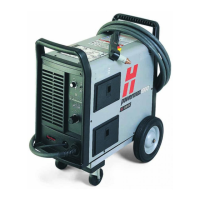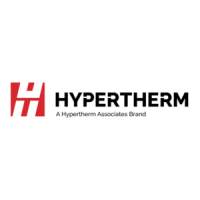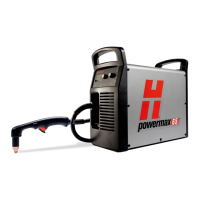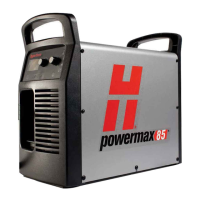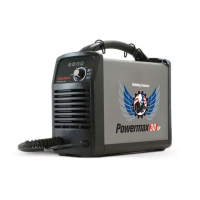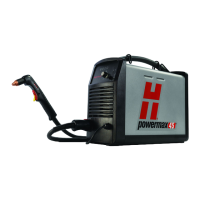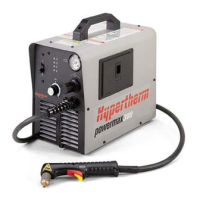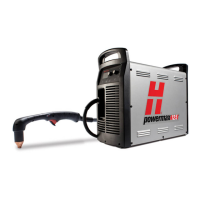Powermax125 Service Manual 808070 107
7 – Mechanized Cutting
High-speed dross forms when the cutting speed is too fast and the arc angles behind. It forms as a thin, linear bead of
solid metal attached very close to the cut. It is more firmly attached to the bottom of the cut than at low speed and is
difficult to remove. To reduce high-speed dross:
Decrease the cutting speed.
Decrease the torch-to-work distance.
Piercing a workpiece using the machine torch
As with the hand torch, you can start a cut with the machine torch at the edge of the workpiece or by piercing the
workpiece. Piercing may result in a shorter consumable life than with edge starts.
The cut charts include a column for the recommended torch height when starting a pierce. For the Powermax125, the
pierce height is generally between 1.5 and 4 times the cut height. Refer to the cut charts for specific values.
The pierce delay must be long enough that the arc can pierce the material before the torch moves, but not so long that
the arc “wanders” while trying to find the edge of a large hole. As consumables wear, this delay time may need to be
increased. Pierce delay times given in the cut charts are based on average delay times throughout the life of the
consumables.
When piercing materials close to the maximum thickness for a specific process, consider the following important factors:
Allow a lead-in distance approximately equal to the thickness of the material being pierced. For example, 20 mm
(3/4 in) material requires a 20 mm lead-in.
To avoid damage to the shield from the buildup of molten material created by the pierce, do not allow the torch to
descend to cut height until it has cleared the puddle of molten material.
Different material chemistries can have an adverse effect on the pierce capability of the system. In particular,
high-strength steel with a high manganese or silicon content can reduce the maximum pierce capability. Hypertherm
derives mild steel parameters using certified A-36 plate.
Common machine-cutting faults
The torch’s pilot arc will initiate, but will not transfer.
The work lead is not making good contact with the cutting table, or the cutting table is not making good contact with
the workpiece.
The torch-to-work distance/cut height is too large.
The workpiece is not totally pierced, and there is excessive sparking on the top of the workpiece.
The metal surface is not clean of rust or paint.
The consumables are worn and need to be replaced. For optimized performance in a mechanized application, replace
the nozzle and the electrode together.
The work lead is not making good contact with the cutting table, or the cutting table is not making good contact with
the workpiece.
The current (amperage) is set too low. See Machine Torch Setup on page 67.
The cut speed is too high. See the cut charts under Using the cut charts on page 77.
The metal being cut exceeds the maximum capacity for the selected amperage. See Specifications on page 19.
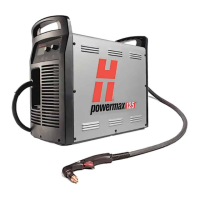
